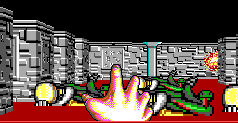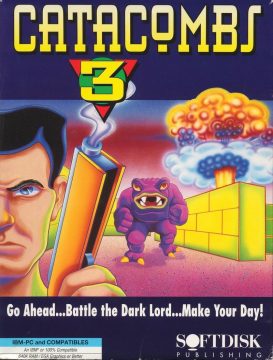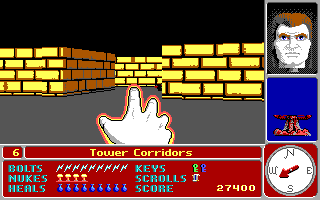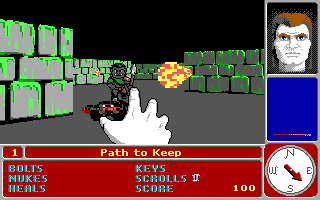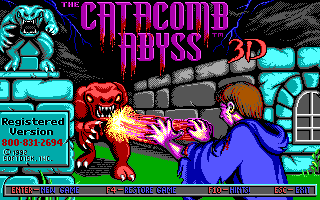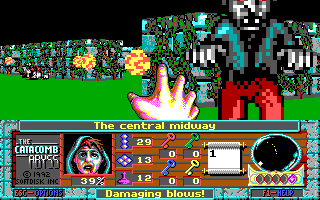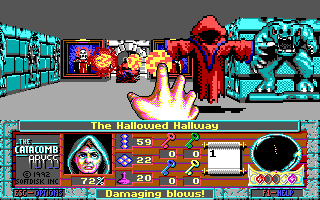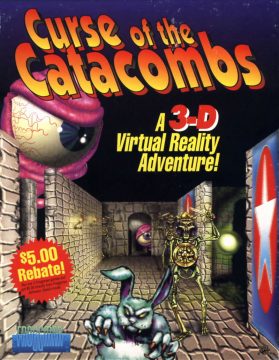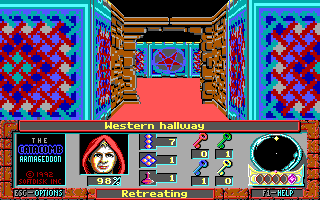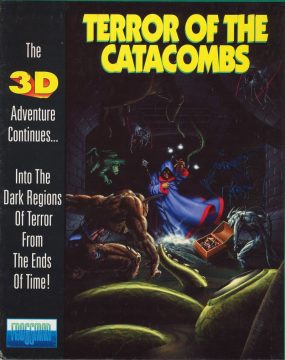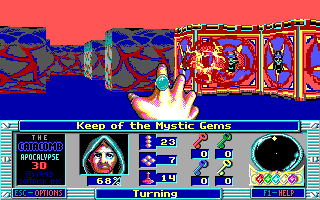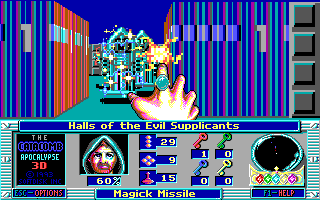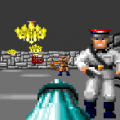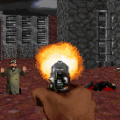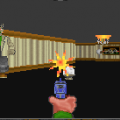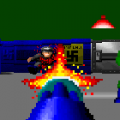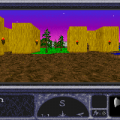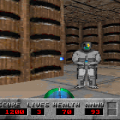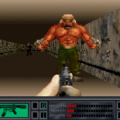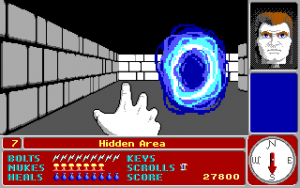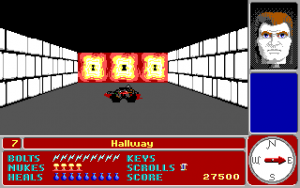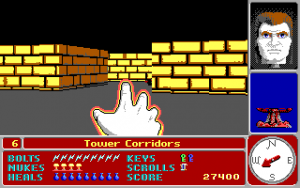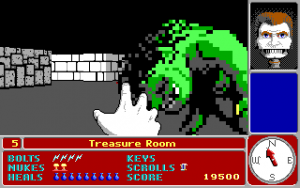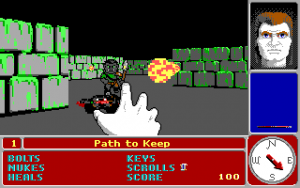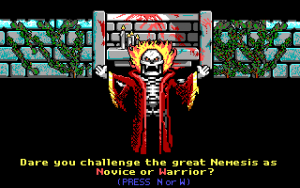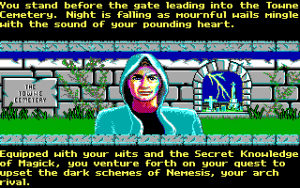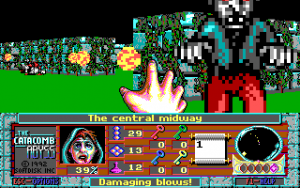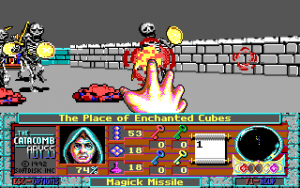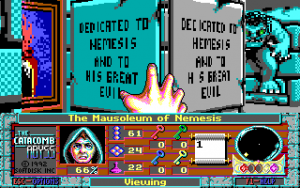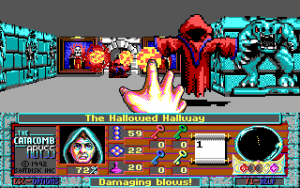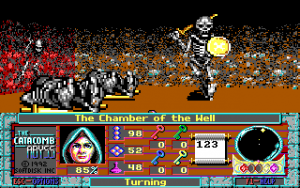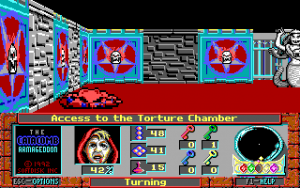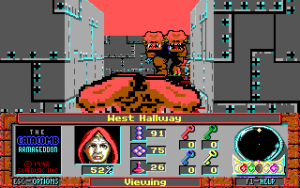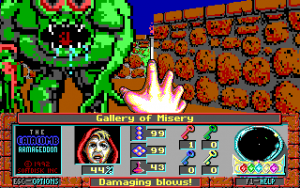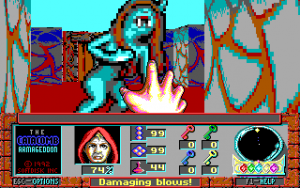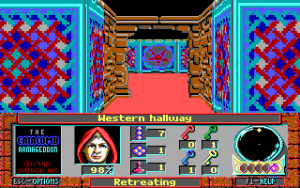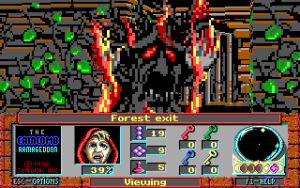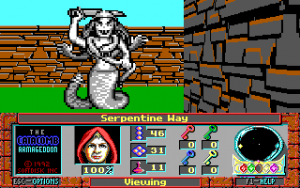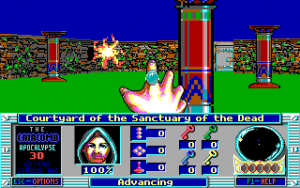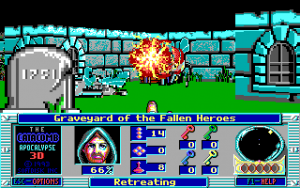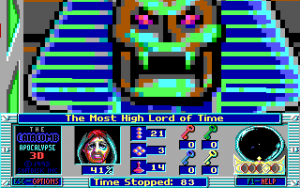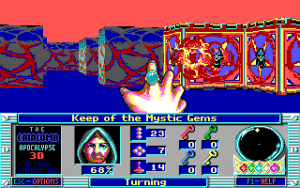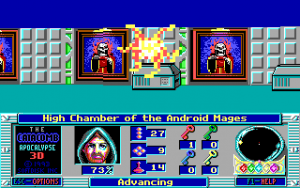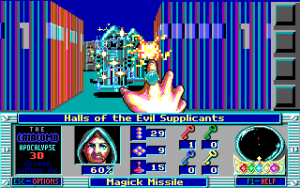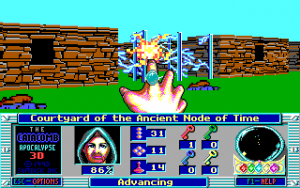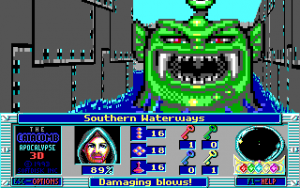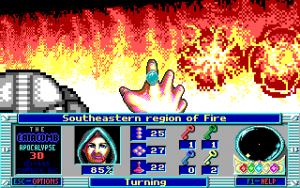Part Two: The 3-D Quadrilogy
Catacomb 3-D: The Descent / Catacombs 3 – PC(1992)
By the time the Catacomb series got underway, John Carmack had moved forward to development with possible ideas about using raycasting and movement within a 3D world. The first game using this engine was Hovertank 3-D, which was crude and rudimentary but achieved that purpose. It was one of the first offerings from the newly formed unit that Carmack had started with fellow Softdisk employees Adrian Carmack, Hall, and Romero, and they called themselves Ideas from the Deep. They later shortened the name to id Software.
Under the agreement id Software had drawn up with Softdisk to be able to pursue their own interests, they were contractually obligated to provide a new game to be published every two months. At this time Softdisk was publishing Gamer’s Edge, a gaming- centric PC magazine helmed by Romero. Carmack had the idea to reboot the earlier Catacomb games, except this time present it from the player’s point of view. Catacomb 3-D became that result, which built upon the earlier engine laid out by Hovertank 3-D and added texture mapping and other advancements.
Catacomb 3-D once again puts the player in the role of master wizard Petton Everhail, who must save his friend from the evil lich Grelminar. The most obvious change from the previous Catacomb games is, of course, the first-person perspective. Even those accustomed to playing FPS may need to adjust their perceptions when playing Catacomb 3-D, as there is a trick employed that causes the walls of the rooms to look flatter as the view scrolls away of them, giving the game a bit of an off-kilter look, and sometimes causes trouble with the character getting stuck in or around corners (Later games, such as Wolfenstein 3-D have the walls appearing the same shape from every angle). Health bars and shot power are now shown as graphical meters. For the former, Petton’s face slowly turns into a skeleton until he is dead, and for the latter, a mushroom cloud becomes fully formed when the super shot is ready to be fired.
But despite the changes from its predecessor, Catacomb 3-D also shares a lot with its previous titles. Petton has retained his ability to strafe, which makes going around corners easier to assess. Bolts and nukes are still present and act in the same manner as before, albeit much scarcer to find in this version. Instead of casting spells from scrolls, in this game scrolls provide hints and clues to progress farther in the game. Fake walls also abound like in the original and can be shot for secret passageways, hidden items and other bonuses.
GT Interactive re-released the game for the retail market under the game Catacombs 3, even though there was never an official “Catacombs 2” (The PC expanded version of Catacombs titled The Catacomb has been regarded as an unofficial sequel). What’s even more confusing is that the cover art depicts a man holding a smoking gun – despite the fact that guns have never been used in the Catacomb universe! Ironically, it was probably done that way to sway those who were interested or had already beaten Wolfenstein 3D into delving into another shoot-em-up type of game. GT Interactive’s partnership with id would continue as Doom and Doom II would become hits for the publishing company.
The Catacomb Abyss – PC (1992)
After Catacomb 3-D: The Descent was released, id Software continued experimenting with first-person perspective and 3-D modeling and developed a little known game called Wolfenstein 3-D. Wolfenstein, of course, became an overnight sensation, which meant that the team was no longer interested in going back to the Catacomb well. Softdisk, however, saw potential in creating a franchise out of it as they had done with the original Catacomb series. Thus, a new team was assembled to create the unofficial official sequel of The Abyss, headed by Greg Malone (who had created/designed Moebius and its sequel Windwalker, worked on Ultima VI and would go on to direct Duke Nukem 3D).
Using id’s Catacomb 3-D engine, the concept was revamped and given a makeover. The player can no longer shoot a charged shot and must fire a normal shot at all times. Instead of a life meter, the character’s face is shown with visible injuries the more he is injured, which would also be later implemented in games like Doom and Wolfenstein 3D. Bolts, nukes and potions remain the same functionally but are renamed to Zappers, Xterminators and Cures, most likely because of their first letters being in proximity to each other on the keyboard. The interface is improved in that each item is given a numerical value instead of displaying the first eight or so icons of the inventory. Now the player actually knows how many of each item they are carrying instead of just guessing that there are a lot, although there is a maximum of 99 of each item.
That may seem like a lot but items are abundantly plentiful in this game, moreso than any other Catacomb title. Since the game no longer keeps track of score, treasure chests instead contain a varying combination of items. To counteract this, items can now be destroyed when fired upon. Even with this measure, however, it’s not uncommon for the player to actually reach that limit of 99 items unless they keep their fingers planted on the bottom row of the keyboard. There’s also a radar called the Crystal Sphere which displays enemies and the player’s shots. However, it only works fully when five Gems are collected, making it largely ineffective for most of the early part of the game. False walls also play an important role in the game. This time around, they are marked differently than the rest of the themed look of the level so they are easier to spot (such as lit windows along a wall or paintings hanging up).
Overall movement feels sluggish compared to The Descent, especially in turning, but it could in part due to the fact that Abyss is using the same engine, but more detailed and filled with more objects than the previous game.
The Catacomb Armageddon / Curse of the Catacombs – PC (1992)
Although Softdisk had developed Catacomb 3-D as a trilogy starting with Abyss only the first title was released through shareware. The next two games in the trilogy, Armageddon and Apocalypse were only available by ordering them directly through Softdisk (by way of their Gamer’s Edge label). All of the games were developed as standalone adventures, and only hold the barest of plot threads connecting each title in the series. In Armageddon, the character (possibly still Petton Everhail, although no longer referred to by name) is still on the hunt to take down the evil Nemesis.
Gameplay offers more of the same as Abyss, although the enemies and level environments are different than the first game. The violence also seems to have been ramped up from the previous title, with some enemies now dying and exploding in a variety of colorful ways. Otherwise, Armageddon remains largely unchanged as the second title in the trilogy.
Shortly after the initial release, Froggman re-released the game under the title Curse of the Catacombs. Froggman was a short-lived budget line of games and a subsidiary of Expert Software. Froggman routinely took Softdisk releases and gave them alternate names and new intro screens for the retail market (Shadow Knights became Budo: The Art of Ninja Combat, Rescue Rover 2 became Dognapped!). Although the Froggman label folded quickly thereafter, Expert Software earns a footnote for publishing a series of Sega Saturn games for the PC platform (Daytona USA, Panzer Dragoon, Virtua Cop and others). Expert Software was bought out by Activision in 1999.
The Catacomb Apocalypse / Terror of the Catacombs – PC (1993)
Catacomb Apocalypse takes place some time after Armageddon and now Petton-cum-player-avatar has become a grizzled old wizard. Still on the trail of Nemesis, his adventure takes him to the Sanctuary of the Dead to defeat him once and for all.
Apocalypse has enough to keep players interested in the conclusion of the series. It uses a non-linear hub system that allows the player a choice between which levels to go to and involves skipping back and forth between levels in order to progress further. This had not been used since the original Catacomb 3-D (and Ether Quest before that). To show that time progression that has elapsed since Armageddon, the player-character now has facial hair and wears a ring on his shooting hand (Perhaps to signify that how advanced of a wizard he has now become?).
One thing that Apocalypse does that separates itself from the rest of the series is introducing the concept of “invisible walls.” These are not the false walls that are shot to reveal passageways, but instead, remain whole but the player can pass right through them. The game itself provides hints on where these walls may be located (“You feel a faint breeze from behind the wall…”), but otherwise they are undetectable. It may not seem like much, but it shows that the developers were still thinking of new ways to progress the Catacomb series.
Froggman once again re-released The Catacomb Apocalypse under the new title Terror of the Catacombs, and once again put a new intro screen and copyright section up but changed little else. For some inexplicable reason, the Froggman version retains the youthful avatar from the first two games in the trilogy, but keeps the new ring that the wizard is now sporting. Otherwise, it is faithful to the original Apocalypse release.
After the release of Sand Trap, the lastgame chronologically, there were no more mentions of catacombs or Petton Everhail. Wolfenstein 3D became the de facto first-person shooter and id would continue their legacy with a string of mega-hits that would take them to the top of the PC gaming world. The same could not be said of Softdisk, who by the mid-90’s would slowly close down their magazine publishing arm as the BBS and Internet grew into the primary method for transferring games between producer and consumer. Softdisk embraced the Internet area as a local ISP in the Shreveport, Louisiana area, but its time, too, was finite. By 2006, the company had all but closed down and all of the intellectual property had been transferred to a different holder. Although Catacomb remains obscure, it has not been forgotten. Flat Rock Studios currently holds the rights to the entire series and has not only released them for digital retailers such as Good Old Games, but has also freely released the original source code as well. It remains an important milestone not only in the development of the first-person shooter genre, but also for a group of developers just on the cusp of greatness.
